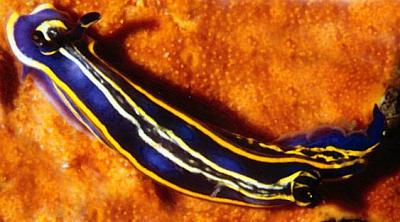
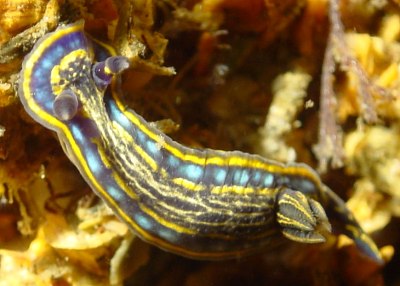
Hypselodoris bilineata
(Pruvot-Fol, 1953)
Order: NUDIBRANCHIA
Suborder: DORIDINA
Superfamily: EUDORIDOIDEA
Family: Chromodorididae
DISTRIBUTION
Atlantic Ids, West Africa, western Mediterranean
PHOTO
Upper Photo: El Timoncillo Reef, Bay of Algeciras (Strait of Gibraltar, southern Spain) at 17 m depth (19.8ºC), size: 25 mm long. August, 2000. Photo: Alma Sánchez.
Lower Photo: Dakar, Senegal, Eastern Atlantic, Site: Tacoma Wreck, Depth: 12m. May 26, 2003. Size: 25-30mm. Photo: Marina Poddubetskaia
The mantle is essentially black with yellow markings and lines and bright blue markings. The edge of the mantle has a thin black line then a submarginal bright yellow or creamy yellow line. Sometimes a section of a yellow line can have a path of white. In the centre of the mantle are a pair of yellow lines which run anteriorly between the rhinophores then join as a loop just in front. Posteriorly the lines run around the edge of the gill pockets and join behind it. Between these median yellow lines and the yellow border the mantle is black with large elongate patches of bright blue. The rhinophore stalk is black and the club dark blue-black with a yellow line around the base of the club and up the posterior midline. The gills are dark blue black with a single yellow line along the inner edge and a double yellow line along the edges of the broad outer rachis. The sides of the body and the foot are blue. with one or two longitudinal yellow lines which join on the postero-dorsal part of the foot. This species was described by Pruvot-Fol from Morocco, and matches Alma Sánchez's photos in the Forum from southern Spain. It grows to at least 30mm in length.
There is some variation in colour pattern in this species. In the northern part of its range the median pair of yellow lines can sometimes merge into a single line. In other animals there can be a few white streaks between the yellow lines. Further south, the yellow lines an be separated by a broad median region with many broken white lines. See message & photos below discussing this colour form with multiple white lines.
References:
• Bouchet, P. (1975) Nudibranches nouveaux des cotes du Senegal. Vie et Milieu, 25(1): 119-132
• Edmunds, M. (1981) Opisthobranchiate Mollusca from Ghana: Chromodorididae. Zoological Journal of the Linnean Society, 72(2): 175-201.
• Ortea, J., Valdés, A. & and García-Gómez, J.C. (1996) Revisión de las especies atlánticas de la familia Chromodorididae (Mollusca: Nudibranchia) de grupo cromático azul. [Review of the Atlantic species of the family Chromodorididae (Mollusca: Nudibranchia) of the blue chromatic group.] Avicennia, 1996, Suppl. 1: 1-165.
• Pruvot-Fol, A. (1953) Etude de quelques opisthobranches de la cote Atlantique du Maroc et du Senegal. Travaux de l'Institute Scientifique Cherifien, Zoologie, 5: 1-105. (Pls. 1-3)
Rudman, W.B., 2003 (May 4) Hypselodoris bilineata (Pruvot-Fol, 1953). [In] Sea Slug Forum. Australian Museum, Sydney. Available from http://www.seaslugforum.net/find/hypsbili
Related messages
Hypselodoris bilineata from Portugal
June 2, 2006
From: David Abecasis
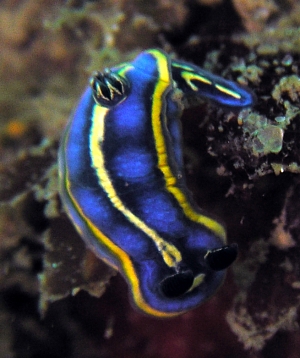
Hello Bill,
Here's another specimen on which I have some doubts. The central line seems to extend beyond the rhinophores, ending in a "T" just like it is supposed to in Hypselodoris fontandraui. On the other end it looks like the rhinophores have a yellow line like in H. cantabrica, although no yellow spots are present.
Locality: Faro, 14 metres, Portugal, Atlantic Ocean, 20 April 2006, rocky bottom. Photographer: David Abecasis.
I hope you can help me out!
Many thanks,
David
dabecassis@ualg.pt
Abecasis, D., 2006 (Jun 2) Hypselodoris bilineata from Portugal. [Message in] Sea Slug Forum. Australian Museum, Sydney. Available from http://www.seaslugforum.net/find/16622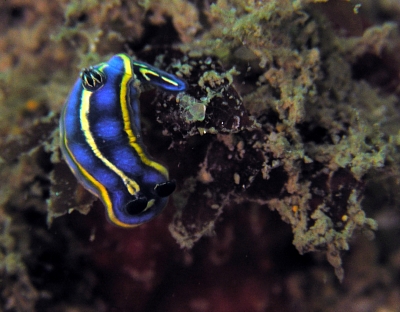
Dear David,
I also hope I can help you out - but I do have my hesitations concerning the Atlantic blue chromodorids. Two features of the colour pattern stand out in this animal. One is the anterior part of the median yellow line, which is double, and the second is the way the light blue patches fill up most of the space between the midline of the mantle and the border. I think these are both unique characters of H. bilineata. It's name 'bilineata' [= two lines] reflect the double yellow lines down the midline, which often merge into one. Quite a few species have a row of light blue patches on the mantle, but they usually form a broken line close to the outer edge of the mantle, rather than filling the space.
So I think this is Hypselodoris bilineata. In your photo the animal seems to be on a reddish brown sponge, but I could be wrong. This species is reported to feed on species of Dysidea, but this doesn't look like a Dysidea. If you have a photo showing the sponge more clearly I would be very interested.
Best wishes,
Bill Rudman
More Hypselodoris bilineata from Senegal [1]
July 17, 2003
From: Marina Poddubetskaia
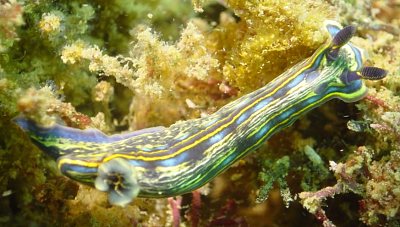

Dear Bill,
Here are some more photos of Hypselodoris bilineata from Dakar, where this species is quite common. Here, rhinophores and gills can be seen better.
Upper Photo:
Date: June 05, 2003
Location: Senegal, Eastern Atlantic
Site: Terou baye Sogui
Depth: 4m
Size: 30-35mm
Lower Photo:
Date: May 26, 2003
Location: Dakar, Senegal, Eastern Atlantic
Site: Tacoma Wreck
Depth: 12m
Size: 25-30mm
Photos: Marina Poddubetskaia - Nembro website
All the best,
Marina.
nembro@nembro.info
Poddubetskaia, M., 2003 (Jul 17) More Hypselodoris bilineata from Senegal [1]. [Message in] Sea Slug Forum. Australian Museum, Sydney. Available from http://www.seaslugforum.net/find/10373Thanks Marina,
I have posted close-ups of the gills and rhinophores in a separate message. Your extra photos certainly help to illustrate the important features of its colour pattern
Best wishes,
Bill Rudman
More Hypselodoris bilineata from Senegal [2]
July 17, 2003
From: Marina Poddubetskaia
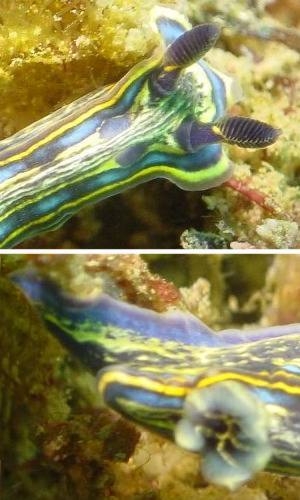
Dear Bill,
Here are close-ups of the gills and rhinophores of the Hypselodoris bilineata from Dakar, in my other message.
Upper Right Photos:
Date: June 05, 2003
Location: Senegal, Eastern Atlantic
Site: Terou baye Sogui
Depth: 4m
Size: 30-35mm
Lower Photos:
Date: May 26, 2003
Location: Dakar, Senegal, Eastern Atlantic
Site: Tacoma Wreck
Depth: 12m
Size: 25-30mm
Photos: Marina Poddubetskaia - Nembro website
All the best,
Marina.
nembro@nembro.info
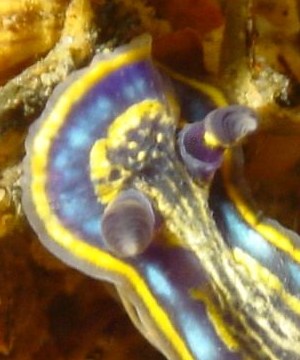
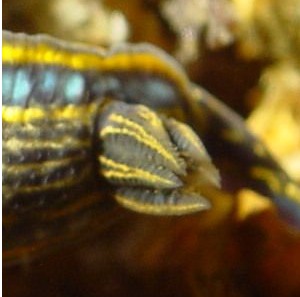
Hypselodoris bilineata from Senegal
May 5, 2003
From: Marina & Patrice
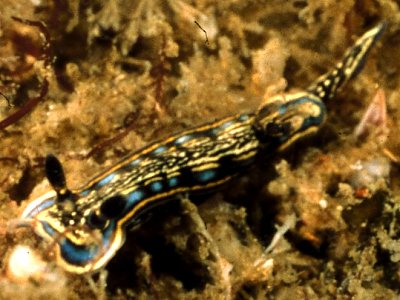
Dear Bill,
Here is another blue dorid from Dakar, Senegal. Is it Hypselodoris malacitana?
This specimen was photographed by Patrice Petit de Voize on the M'bao wrecks in April 1999, at a depth of 9m.
Best wishes,
Marina Poddubetskaia
nembro@nembro.info
Patrice Petit de Voize
PdeVoize@aol.com
Poddubetskaia, M. & Petit de Voize, P., 2003 (May 5) Hypselodoris bilineata from Senegal. [Message in] Sea Slug Forum. Australian Museum, Sydney. Available from http://www.seaslugforum.net/find/9683Dear Marina & Patrice
This is another of the confusing 'blue chromodorids'. Although rather different in colour from 'typical' specimens, this is considered to be a colour form of H. bilineata. This colour form has been reported from Ghana (Edmunds, 1971) and Senegal (Bouchet, 1975; Ortea etc al., 1996). Bouchet considered the colour differences were because Pruvot-Fol's Morocan animals were juveniles, but as adults of her colour form have been reported, it seems the difference may be geographic.
The main colour differences are that in the Ghanaian / Senegalese colour form the median yellow lines are much further apart, and between them are many broken creamy yellow or white lines. The black zone, between the inner yellow line and the yellow border, is much narrower and the blue pigmentation forms a blue line around the anterior end of the mantle and a series of spots down each side. Although these colour forms look rather different, if you look at the photo in the Fact Sheet of a 'typical' colour form from southern Spain, you can see a few white streaks in the centre of the mantle between the two yellow lines, which no doubt are a link between this colour form and the forms from further south with multiple white lines.
• Bouchet, P. (1975) Nudibranches nouveaux des cotes du Senegal. Vie et Milieu, 25(1): 119-132
• Edmunds, M. (1981) Opisthobranchiate Mollusca from Ghana: Chromodorididae. Zoological Journal of the Linnean Society, 72(2): 175-201.
• Pruvot-Fol, A. (1953) Etude de quelques opisthobranches de la cote Atlantique du Maroc et du Senegal. Travaux de l'Institute Scientifique Cherifien, Zoologie, 5: 1-105. (Pls. 1-3)
Best wishes,
Bill Rudman
Hypselodoris bilineata from Spain
November 6, 2001
From: Luis Sánchez Tocino
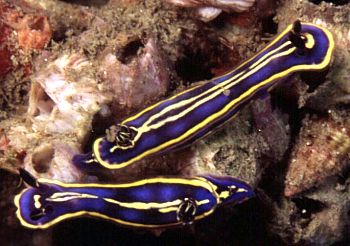
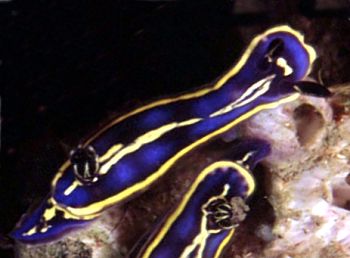
Dear Dr. Rudman,
Here some photos of Hypselodoris bilineata. They are from Punta del Vapor, Almuñecar, Granada, on the Mediterranean coast of Spain. I have sent some close-up photos of the colour of particular parts of the body in a separate message.
Luis
lstocino@ugr.es
Sánchez Tocino, L, 2001 (Nov 6) Hypselodoris bilineata from Spain. [Message in] Sea Slug Forum. Australian Museum, Sydney. Available from http://www.seaslugforum.net/find/5622Thanks Luis,
Bill Rudman
Hypselodoris bilineata from Spain (2)
November 6, 2001
From: Luis Sánchez Tocino
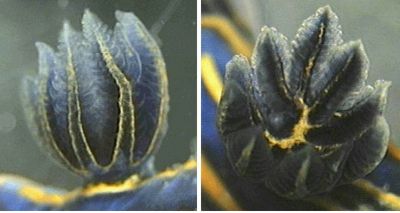
Dear Dr. Rudman,
Here some close-up photos of Hypselodoris bilineata showing the gills, rhinophores and head region, to accompany my earlier message.
Luis
lstocino@ugr.es
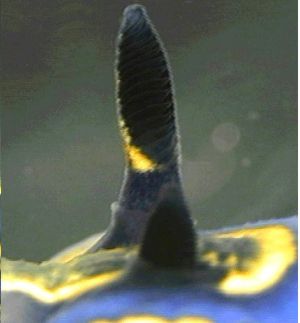
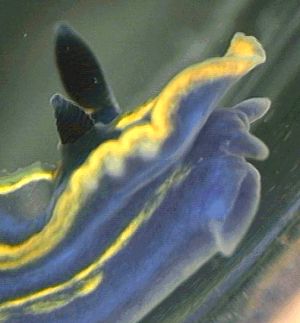
Thanks Luis,
Bill Rudman
Hypselodoris bilineata from Spain
March 5, 2001
From: Alma Sánchez

Dear Dr. Rudman,
Here is a photo of Hypselodoris bilineata (Pruvot-Fol, 1953). This specimen was collected in August, 2000 at the Bay of Algeciras (Strait of Gibraltar, southern Spain) at 17 m depth (19.8ºC), size: 25 mm long., place: El Timoncillo Reef. (Specimen identified by Dr. Ángel Váldes)
Best wishes,
Alma Sánchez.
Almasanchez83@hotmail.com
Sánchez, A., 2001 (Mar 5) Hypselodoris bilineata from Spain. [Message in] Sea Slug Forum. Australian Museum, Sydney. Available from http://www.seaslugforum.net/find/3900Thanks Alma,
Another of the blue chromodorids from the Atlantic - Caribbean region. I thought initially that the double median line was a good character, but I see from Ortea et al (1996) that this is not always so, in some cases there being a single line and in others there are multiple longitudinal lines on the central part of the mantle.
Best wishes,
Bill Rudman
